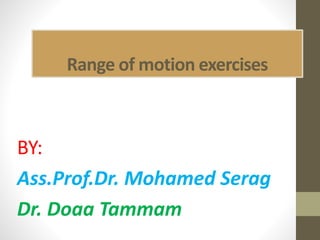
3d passive ROM ex.pptx
- 1. Range of motion exercises BY: Ass.Prof.Dr. Mohamed Serag Dr. Doaa Tammam
- 2. Definition of ROM : Is measurement of the amount of movement around specific joint, measured in degrees.
- 3. • -Therapist can help to improve joint function by focusing on ROM exercises. the goal of these ex.: is to gently increase ROM and decrease pain, swelling and stiffness.
- 4. Types of ROM EX.: •1- Passive range of motion exercise: (PROM) •Movement performed within unrestricted ROM by external force (Therapist or equipment moves the joint through the ROM) without any muscle contraction done by patient . (no voluntary motion)
- 6. • 2-Active assisted range of motion exercise: (AAROM) • Movement performed within the unrestricted ROM controlled by the voluntary contraction of the muscle , in which assistance is provided by outside force (therapist or equipment )to complete the ROM with gravity elimination.
- 7. • 3- Active range of motion exercise: (AROM) •Movement performed by patient’s own muscular effort within the un restricted ROM without any assistance or resistance of any external force other than gravity.
- 9. Types of passive movement: •1- Relaxed passive movement: •( to maintain unrestricted ROM) •2- Stretching passive movement: (to increase restricted ROM) •3-Mobilizing passive movement: •(to increase ROM and break down adhesion)
- 10. Relaxed passive movement: • Goals of relaxed passive movement: • 1- to maintain unrestricted ROM • 2-Inhebit pain and reduce edema • 3-improve circulation and vascular system • 4-increase nutrition to joint capsule • 5- assist in healing process of fracture or surgery • 6-provide sensory stimulation and awareness • 7-used to evaluate ROM, stability ,flexibility and muscle tone • 8- use it during teach active ex.
- 11. Indications of relaxed passive movement: •1- Paralyzed Patient •2- Comatosd Patients •3- Immobilization •4- Surgical Interference •5- Muscle Re-education
- 12. Contraindicationsof relaxed passivemovement: • 1- Fever • 2- Acute Inflammation • 3- Recent Injury E.G Fracture • 4- Abnormal Blood Pressure • 5- DVT • 6- Open Wound • 7- Sever Pain
- 13. Characteristicsof relaxed passivemovement: •1- Slowly •2- Rhythmic •3- Regular •4- Through Full ROM
- 14. Principleof application of relaxedpassivemovement • 1- Complete Evaluation • 2- Preparation For Patient: • a- patients should be in comfortable ,relaxed and good alignment position • b- Free the region from restriction of clothes, splints ,cover the other parts
- 15. • 3- Therapist should be maintaining the body mechanics (therapist position must be near to the center of gravity of the part to be treated realizing inner and outer hand and standing with wide base of support • 4- The vital signs should be measure before and after ex.(blood pressure ,temperature and pulse rate) • 5- Sufficient space and place to perform movement
- 16. • 6- preparation for application: • - to control the mov. Grasp the extremity around the joint, if the joints are painful modify the grasp. • -Support the area of poor structural integrity (hypermobility ,or paralyzed limb) • -Move the limb smoothly and rhythmically , also don’t apply force or pressure at end of movement. • -Grasp should be firm not harmful. • 7-repeated the movement 5-10 times according to patient condition and response
- 17. Limitation for passive movement: •Passive ROM EX doesn't : -Prevent atrophy -Increase strength and endurance
- 18. THANK YOU